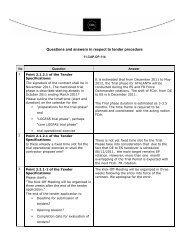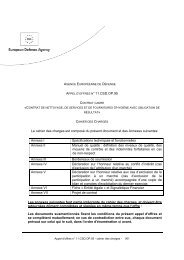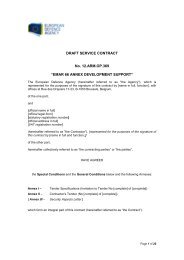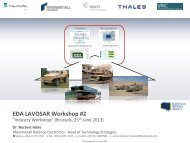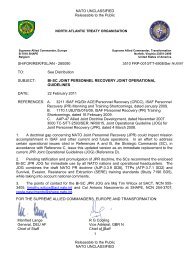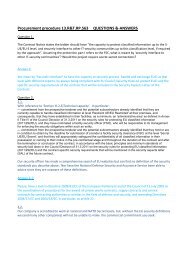capability development plan - European Defence Agency - Europa
capability development plan - European Defence Agency - Europa
capability development plan - European Defence Agency - Europa
You also want an ePaper? Increase the reach of your titles
YUMPU automatically turns print PDFs into web optimized ePapers that Google loves.
60<br />
THREATS AND CHALLENGES DERIVING FROM<br />
POTENTIAL ADVERSARIES<br />
• Ex-Soviet high altitude interceptors maybe to upgraded to, for example MiG-31 ‘Foxhound’<br />
interceptors in the E export configuration, in exchange for the older Foxbats. Such aircraft has beyond<br />
visual range air-to-air missiles and phased array radar (facilitating the simultaneous engagement of up<br />
to four targets, including those with aspects below and behind).<br />
• Other contenders may include surplus MiG-29 or Su-27 variants. Should funding allow, then a newbuild<br />
and customised Su-30 variant-type would be a likely contender to fill this role.<br />
• Ex-US aircraft could be replaced by F-16 upgrades. An active Electronically Scanned Array (AESA)<br />
radar would dramatically increase the target identification and engagement <strong>capability</strong> of the aircraft.<br />
Specifically, an AESA system offers advantages in terms of simplicity of design, maintenance and<br />
operation due to the lack of moving parts. Systems also offer a much faster scanning rate as they are<br />
not restricted by the physical rotation of the system, a much higher range and larger number of targets<br />
able to be tracked and engaged due to the possibility of multiple agile beams. Lastly, AESA systems<br />
offer a lower probability of intercept and improved resistance to ECM measures due to the agility of the<br />
beam emitted.<br />
• Current air lift <strong>capability</strong> is nearly always both insufficient and nearing the end of its effective service<br />
life. Such adversaries may select Antonov An-70 and/or An-74s to provide the <strong>capability</strong> required.<br />
• There is potential for C-130J to be sourced as surplus from allied nations who have replaced them<br />
C130 Hercules © EUFOR Tchad RCA<br />
with next-generation lift aircraft currently under <strong>development</strong> such as the A400M.<br />
• It is expected a primary area for system procurement is in its air defence assets, including modern<br />
mobile air defence systems from Russia. Such systems are capable providing good, low-medium<br />
altitude coverage as part of a wider air defence umbrella.<br />
• Some adversaries will seek to obtain an advanced area high-altitude air-defence system. The most<br />
desirable is, perhaps, a Russian fourth generation system, optimised to defeat a range of advanced<br />
threats including ballistic and tactical missiles, low signature stealth aircraft, AWACs-type aircraft and<br />
stand-off electronic warfare aircraft.<br />
• It is expected that vehicle fleets will be upgraded around wheeled 8x8 hull design able to field variants<br />
capable of fulfilling numerous roles. As more advanced nations using such a vehicle replace them with<br />
network centric platforms then large numbers of surplus vehicles will become available on the market.<br />
The addition of a remote weapon station or manned turret affording Infantry Fighting Vehicle (IFV)<br />
<strong>capability</strong>. There would be growth potential into the area of linked data transfer systems associated<br />
with the first stages of network centricity.<br />
• It is likely to see some procurement is that of Mine-Protected Mobility Vehicles to provide high-mobility<br />
units with suitable protection. Furthermore, such procurement would allow the opportunity to replace<br />
existing mobility firepower assets operating in ATGW and air defence roles.<br />
• There is some potential for substantially increase attack helicopter <strong>capability</strong>. Millimetre wave fire<br />
control radar was designed to provide target acquisition and engagement of (predominantly) armoured<br />
vehicles with missile fire whilst the parent aircraft remained behind cover.<br />
• Heavy armour upgrade is likely. Systems and <strong>capability</strong> upgrades may be included in any such<br />
programme include external command and control communication systems, a battle management<br />
system with appropriate tactical displays, improved internal intercom systems, an under-armour<br />
auxiliary power unit, improved crew compartment cooling and conditioning systems and an optronics<br />
package including infra-red thermal commander’s sight.<br />
• It is not expected to have made significant strides towards network centricity. However, there are<br />
areas in which advancement is expected to be made. Firstly, the adoption of western doctrine may<br />
bear fruit in the <strong>plan</strong>ning and execution of combined arms operations featuring armour, infantry and<br />
airborne assets. This <strong>development</strong> will be assisted by advances in the basic command and control<br />
process and procedures, including the first steps in sharing of data and communications systems<br />
between platforms such as close support aircraft and armoured vehicles.<br />
FUTURE TRENDS FROM THE CAPABILITY DEVELOPMENT PLAN




